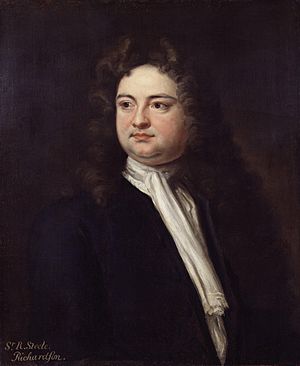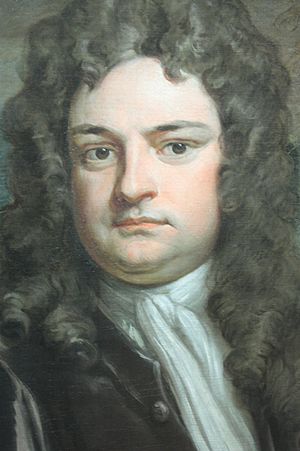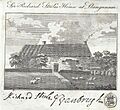Richard Steele facts for kids
Quick facts for kids
Richard Steele
|
|
|---|---|

Portrait by Jonathan Richardson
|
|
| Born | 12 March 1672 Dublin, Ireland
|
| Died | 1 September 1729 (aged 57) Carmarthen, Wales
|
| Nationality | British |
| Alma mater | Christ Church, Oxford Merton College, Oxford |
| Occupation | Writer and politician |
| Known for | Founder of The Spectator |

Sir Richard Steele (born March 12, 1672 – died September 1, 1729) was an Irish writer, playwright, and politician. He is best known for starting the magazine The Spectator with his friend Joseph Addison.
Contents
His Early Life
Richard Steele was born in Dublin, Ireland, in March 1672. His father was a rich lawyer, and his mother was known for her beauty. Sadly, his father died when Richard was four, and his mother passed away a year later.
Richard was mostly raised by his aunt and uncle. He went to Charterhouse School, where he first met Joseph Addison. Later, he studied at Christ Church, Oxford and Merton College, Oxford.
After college, he joined the army to fight in King William's wars against France. He became an officer in 1697 and a captain within two years. Steele left the army in 1705. In 1706, he started working for Prince George of Denmark, who was married to Queen Anne.
Getting Involved in Politics
Steele became a Whig Member of Parliament (MP) in 1713. The Whigs were a political group in Britain. He was soon removed from Parliament because he wrote a pamphlet supporting the new king, George I of Great Britain.
When King George I came to the throne in 1714, Steele was knighted. This meant he became "Sir Richard Steele." He was also put in charge of the Theatre Royal, Drury Lane, a famous theater in London. He returned to Parliament in 1715.
While at Drury Lane, Steele wrote a successful play called The Conscious Lovers. However, he later had disagreements with his friend Addison and the government. In 1724, he moved to Wales, where he lived for the rest of his life.
Steele was also a member of the Kit-Kat Club, a group of famous writers and politicians.
His Famous Writings
Steele's first published work was The Christian Hero (1701). In this book, he tried to explain what a true hero should be like. He wrote it while he was in the army. However, some people made fun of it because they felt Steele did not always follow his own advice.
That same year, Steele wrote a comedy play called The Funeral. This play was very popular and was performed at Drury Lane. It helped him get noticed by the King. Next, he wrote The Lying Lover, which was one of the first "sentimental comedies" but was not a success on stage.
In 1705, Steele wrote The Tender Husband with some help from Addison. He also wrote the introduction for another play called The Mistake.
Family Life
In 1705, Steele married Margaret Stretch, who passed away the next year. At her funeral, he met his second wife, Mary Scurlock. He called her "Prue." They got married in 1707. Steele wrote more than 400 letters to Mary during their time together.
Mary died in 1718. Their daughter, Elizabeth, was Steele's only child who lived to adulthood. She married John Trevor, who was a Baron. Steele also had another child, Elizabeth Ousley, whom he later adopted.
Steele in Books
Richard Steele appears as a small character in the novel The History of Henry Esmond by William Makepeace Thackeray. In the book, he is called "Dick the Scholar." Thackeray describes Steele as a kind, generous, and talented person who helps the main character when he is young.
Images for kids
See also
 In Spanish: Richard Steele para niños
In Spanish: Richard Steele para niños


